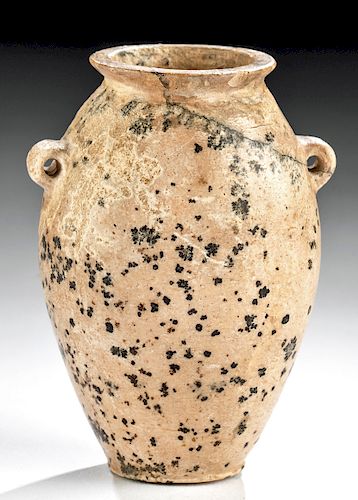Egyptian Predynastic Brecciated Marble Acorn Jar
Lot 4
About Seller
Artemis Fine Arts
686 S Taylor Ave, Ste 106
Louisville, CO 80027
United States
Selling antiquities, ancient and ethnographic art online since 1993, Artemis Gallery specializes in Classical Antiquities (Egyptian, Greek, Roman, Near Eastern), Asian, Pre-Columbian, African / Tribal / Oceanographic art. Our extensive inventory includes pottery, stone, metal, wood, glass and textil...Read more
Categories
Estimate:
$3,500 - $5,000
Absentee vs Live bid
Two ways to bid:
- Leave a max absentee bid and the platform will bid on your behalf up to your maximum bid during the live auction.
- Bid live during the auction and your bids will be submitted real-time to the auctioneer.
Bid Increments
| Price | Bid Increment |
|---|---|
| $0 | $25 |
| $300 | $50 |
| $1,000 | $100 |
| $2,000 | $250 |
| $5,000 | $500 |
| $10,000 | $1,000 |
| $20,000 | $2,500 |
| $50,000 | $5,000 |
| $100,000 | $10,000 |
| $200,000 | $20,000 |
About Auction
By Artemis Fine Arts
Feb 13, 2020
Set Reminder
2020-02-13 10:00:00
2020-02-13 10:00:00
America/New_York
Bidsquare
Bidsquare : Exceptional Antiquities, Asian, Ethnographic
https://www.bidsquare.com/auctions/artemis-gallery/exceptional-antiquities-asian-ethnographic-4848
An important one-day auction featuring museum-worthy examples of Egyptian, Greek, Roman, Etruscan, Near Eastern, Far East / Asian, Pre-Columbian, African / Tribal, Oceanic, Native American, Spanish Colonial, Russian, Fossils, Ancient Jewelry, Fine Art, so much more! Artemis Fine Arts info@artemisfinearts.com
An important one-day auction featuring museum-worthy examples of Egyptian, Greek, Roman, Etruscan, Near Eastern, Far East / Asian, Pre-Columbian, African / Tribal, Oceanic, Native American, Spanish Colonial, Russian, Fossils, Ancient Jewelry, Fine Art, so much more! Artemis Fine Arts info@artemisfinearts.com
- Lot Description
Ancient Egypt, Pre-Dynastic Period, late Naqada II to early Naqada III, ca. 3400 to 3200 BCE. A beautiful and petite vessel that is hand-carved from brecciated marble of a soft tan hue. The jar presents with a planar base, an inverted piriform body with a gently rounded shoulder, a pair of narrow, pierced suspension lugs, and a slender flared rim surrounding the smooth interior cavity. The interior was drilled all the way to the bottom using a series of progressively finer drill bits and copious amounts of abrasive sand, and the shallow grooves left by the drilling are still visible within. Size: 1.875" W x 2.6" H (4.8 cm x 6.6 cm)
In the early Pre-Dynastic period, artisans hollowed out hard stone vessels using hand-held stone borers and abrasive desert sand. Then, during the Naqada II period (ca. 3600 to 3200 BCE), the invention of copper tubes used to drill very hard stone (in conjunction with sand as an abrasive), allowed people to drill finer forms - like the interior of this vessel. In the Naqada III period, people developed stone borers that allowed them to expand beyond a drilled channel, so the shape of this vessel suggests that its makers did not yet have access to that technology.
For a stylistically similar example, please see The Metropolitan Museum of Art, accession number 66.99.198.
Provenance: private East Coast, USA collection; ex-Royal-Athena Galleries, New York, USA, acquired in the 2000s
All items legal to buy/sell under U.S. Statute covering cultural patrimony Code 2600, CHAPTER 14, and are guaranteed to be as described or your money back.
A Certificate of Authenticity will accompany all winning bids.
We ship worldwide and handle all shipping in-house for your convenience.
#152863Repaired area from rim to one suspension lug, with resurfacing and very light adhesive residue along break lines. Minor abrasions and nicks to rim, body, and base, with light encrustations within interior cavity. Smooth patina and nice manganese deposits throughout.Condition
- Shipping Info
-
All shipping is handled in-house for your convenience. Your invoice from Artemis Gallery will include shipping calculation instructions. If in doubt, please inquire BEFORE bidding for estimated shipping costs for individual items.
-
- Buyer's Premium



 EUR
EUR CAD
CAD AUD
AUD GBP
GBP MXN
MXN HKD
HKD CNY
CNY MYR
MYR SEK
SEK SGD
SGD CHF
CHF THB
THB
















